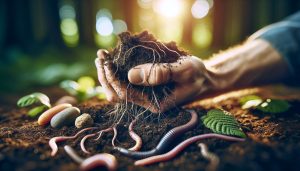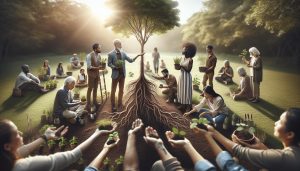In the intricate tapestry of nature, the concepts of food chains and food webs are foundational to understanding ecosystems. Did you know that these structures are vital not only for wildlife but also for maintaining global biodiversity? A food chain illustrates the linear pathway of energy and nutrients as they flow from one organism to another, while a food web showcases the more complex interconnections that characterize real-life ecological interactions. Understanding the difference is crucial for anyone interested in environmental sustainability and conservation efforts. By grasping how these systems function, you empower yourself to make informed choices that contribute to the health of our planet. Dive deeper into the fascinating world of ecological relationships and discover how your actions can impact the delicate balance of life on Earth.
Understanding Food Chains: Simple Definitions Revealed
What happens when you think about your meals? Every bite and every ingredient is linked to a web of life that plays a crucial role in balancing our ecosystems. At the heart of this intricate relationship lies the food chain-a straightforward yet vital concept that illustrates how energy flows through the environment. A food chain is essentially a linear sequence showing who-eats-who within an ecosystem, starting with producers, like plants, that harness solar energy through photosynthesis and ending with apex predators.
Food chains can be categorized into three main types: the grazing food chain, the detritus food chain, and the parasitic food chain. The grazing food chain depicts the flow of energy from plants to herbivores and then to carnivores, forming a clear path of consumption. Alternatively, the detritus food chain focuses on how decomposers break down dead organic matter, returning nutrients to the soil, while the parasitic food chain reveals the relationships where one organism benefits at the cost of another. Understanding these types not only helps in grasping how different species interact but also emphasizes the interconnectedness of various organisms in maintaining ecological balance [2[2].
In essence, the food chain is a pivotal component of a food web, which describes a more complex network of feeding relationships that includes multiple interconnections between different organisms. This complexity highlights the importance of every single link; the extinction of one species can have a cascading effect throughout the ecosystem. By investing in sustainable practices, such as supporting local farms or reducing food waste, individuals can contribute to healthier food systems and promote the vitality of these intricate networks that sustain life on Earth [1[1]. Embracing eco-conscious living begins with recognizing these connections and understanding the impact of our choices on the environment.
What Makes Up a Food Web: Key Components Explained
Every ecosystem is a symphony of interactions, where various organisms play unique roles in the intricate dance of life. A food web represents this complex community of ecological relationships, illustrating how energy and nutrients flow between living entities. Unlike a simple food chain, which presents a direct line of consumption, a food web captures the multitude of feeding relationships present in an ecosystem, demonstrating that organisms are often part of multiple chains and rely on various food sources for survival.
Central to understanding a food web are its key components: producers, consumers, and decomposers. Producers, typically plants and algae, form the foundation by converting sunlight into energy through photosynthesis. This energy is then transferred through various levels of consumers, which can be herbivores (primary consumers), carnivores (secondary or tertiary consumers), and omnivores-each playing a critical role in maintaining balance within the ecosystem. Decomposers, such as fungi and bacteria, break down dead organic matter, returning essential nutrients to the soil, which supports the next generation of producers.
The complexity of a food web emphasizes the importance of biodiversity. A diverse ecosystem is more resilient, allowing it to recover from disturbances such as disease or climate change. When one species is removed or endangered, the impact ripples through the food web, potentially jeopardizing other species. For instance, the decline in bee populations affects not only plant life but also the entire food web dependent on those plants, illustrating the interconnectedness of life.
To support these vital networks, individuals can take actionable steps in their daily lives. Simple practices such as choosing locally-sourced foods, reducing waste, and creating spaces that foster biodiversity-like native gardens-can contribute to healthier ecosystems. By making informed choices and advocating for sustainable practices, we can play a significant role in nurturing the delicate balance of our food webs, ensuring their longevity for future generations.
The Interconnectedness of Ecosystems: Why Food Webs Matter
Understanding the intricate web of life is essential because every organism, from the smallest microbe to the largest predator, is interconnected in a dynamic network of relationships. Food webs, which illustrate these complex feeding interactions, are not just diagrams; they are vital blueprints of ecosystem functionality and health. They reveal how energy and nutrients are cycled through various trophic levels, demonstrating the delicate balance necessary for sustaining biodiversity.
In a food web, each species plays multiple roles, often straddling different trophic levels. For instance, a single organism may serve as both prey and predator, influencing population dynamics across the ecosystem. This interconnectedness means that the health of one species can significantly impact others. When a keystone species-such as a top predator-is removed, it can cause cascading effects throughout the food web, potentially leading to overpopulation of certain species and the decline of others. This ripple effect underscores why conserving biodiversity is essential for fostering resilient ecosystems that can withstand environmental changes and human pressures.
Practical steps individuals can take to support these vital networks include:
- Advocating for conservation efforts: Support local wildlife preserves and eco-friendly legislation.
- Choosing sustainable products: Opt for goods from companies that prioritize environmental stewardship and biodiversity.
- Participating in community initiatives: Engage in local clean-up efforts, tree-planting days, or wildlife monitoring projects.
- Educating others: Share knowledge about the importance of food webs and biodiversity in schools or community groups.
By being mindful of our choices and understanding the profound interconnectedness of life, each of us can contribute to the well-being of ecosystems and the overall health of the planet. This collective action not only protects complex food webs but ensures that future generations inherit a vibrant and balanced environment.
Food Chain vs. Food Web: Key Differences Simplified
The distinction between a food chain and a food web is fundamental to understanding ecological systems. At its core, a food chain is a linear sequence that outlines who-eats-who within an ecosystem, showcasing a simple path of energy flow. For instance, consider a classic example: a plant (producer) is consumed by a herbivore (primary consumer), which is then eaten by a carnivore (secondary consumer). This chain visually represents the direct relationships between species, illustrating how energy is transferred from one organism to another in a straightforward manner.
In contrast, a food web is a more intricate and interconnected representation of how different organisms interact within an ecosystem. It combines multiple food chains, showing that most species occupy various roles-they can be both predator and prey depending on the situation. For example, a fox may consume rabbits, but if food is scarce, it might also feed on berries, illustrating its versatility as an omnivore. This complexity allows food webs to convey a more accurate picture of the ecosystem’s dynamics, highlighting the roles of diverse species and the potential ripple effects of changes within the network.
Understanding these differences is crucial for biodiversity preservation efforts. While food chains provide clarity about direct relationships, food webs emphasize the interconnectedness and dependencies among species. Disrupting one element in a food web can trigger cascading consequences throughout the ecosystem. Thus, supporting biodiversity not only protects individual species but also maintains the intricate balance that sustains all forms of life.
To promote a healthier ecosystem, individuals can take several actionable steps:
- Support local biodiversity: Plant native species in your garden to attract and sustain local wildlife.
- Reduce plastic use: Minimize waste that can pollute habitats and endanger food web populations.
- Engage in community initiatives: Collaborate on projects aimed at restoring local ecosystems and preserving habitats.
- Stay informed: Follow local conservation efforts and participate in discussions on protecting food webs.
By embracing these practices, you not only contribute to the resilience of food webs but also ensure the health and sustainability of our planet for future generations.
Trophic Levels Explained: Producers, Consumers, and Decomposers
Understanding the roles within ecosystems is crucial for our engagement with the environment, particularly when considering how energy and nutrients flow through various organisms. At the foundation of this ecological structure are three primary trophic levels: producers, consumers, and decomposers. These levels serve as the framework for understanding food chains and food webs, illustrating how life sustains life in a delicate balance.
Producers, primarily green plants and phytoplankton in aquatic environments, occupy the first trophic level. They harness solar energy through photosynthesis, converting sunlight, carbon dioxide, and water into glucose and oxygen. This process not only fuels their growth but also provides energy for the entire ecosystem. By planting more native trees and plants in your surroundings, you can directly support these essential producers, enhancing your local ecosystem while contributing to carbon sequestration efforts.
Consumers are categorized into herbivores (primary consumers), carnivores (secondary and tertiary consumers), and omnivores (which consume both plants and animals). Primary consumers thrive on a diet of plants and are crucial for transferring energy up the trophic levels. Secondary consumers, which include predators like foxes and hawks, rely on the energy stored in these herbivores. Tertiary consumers, often apex predators such as eagles or great white sharks, sit at the top of the food web. Understanding your food choices, such as opting for sustainable and local food sources, can help protect these consumer levels and maintain ecological balance.
Decomposers, including fungi and bacteria, are essential for recycling nutrients back into the ecosystem. They break down dead organic matter, enriching the soil with vital nutrients and facilitating new plant growth. By composting organic waste at home, you can actively participate in this critical ecological function. This simple practice not only reduces landfill waste but also supports a thriving environment by returning nutrients to the soil.
In recognizing and respecting these three trophic levels-producers, consumers, and decomposers-we can create a more sustainable community. Empowering individuals to make eco-friendly choices in their daily lives leads to improved biodiversity and supports the intricate web of life upon which we all depend.
Real-World Examples of Food Chains and Food Webs
The intricate web of life is often illustrated through examples of food chains and food webs, both of which showcase the flow of energy and nutrients in ecosystems. For instance, consider a simple food chain in a temperate forest:
- Producers: In this setting, the primary producers are trees such as oaks and maples. Through photosynthesis, they convert sunlight into energy, forming the foundation of the forest ecosystem.
- Primary Consumers: Herbivores like deer or rabbits feed on these plants, drawing energy directly from the primary producers.
- Secondary Consumers: Predators like foxes or hawks may hunt these herbivores, utilizing the energy stored in their bodies to sustain themselves.
- Tertiary Consumers: At the top of this chain, larger predators such as mountain lions gain energy by preying on the secondary consumers.
This linear depiction elegantly simplifies complex interactions, but the true beauty lies in the connections that each organism shares with others. In reality, food webs demonstrate that relationships in ecosystems are far more interconnected and complex. For example, in the same forest, a hawk doesn’t just eat rabbits; it may also prey on squirrels or small birds. Meanwhile, the same deer might be preyed upon by wolves that also share the ecosystem. This network of connections allows for greater resilience against environmental disturbances.
Real-World Impact of Food Webs
Understanding these networks can empower individuals to take actionable steps toward ecological sustainability. By choosing to support local farms and reduce consumption of highly processed foods, one contributes to a healthier food web. When purchasing food, consider gaining knowledge about which herbivores are local and how they fit into the food chain. Engaging in or advocating for sustainable agricultural practices allows for diversified crops and a richer ecosystem, ultimately supporting the health of both producers and consumers.
Moreover, education plays a vital role in this understanding. Initiatives like community gardens or local biodiversity programs can enhance community involvement and awareness. This can encourage people to see beyond their dietary choices and recognize their position in the broader ecosystem, thereby fostering a sense of responsibility towards the environment.
Embracing this concept of interconnectedness inspires a desire to protect the delicate balance of food webs. Each action, such as reducing waste, conserving energy, or adopting a plant-based diet, contributes to a healthier planet. Acknowledging the importance of both food chains and food webs equips us with the knowledge necessary to participate actively in preserving our ecosystems.
The Importance of Biodiversity in Food Networks
The complex web of life on Earth highlights an essential truth: biodiversity is the backbone of healthy food networks. The variety of species within an ecosystem brings stability, resilience, and productivity, ensuring that the network can withstand shocks such as disease outbreaks, climate change, or human impact. Imagine a garden filled with diverse crops; it’s not just beautiful but also more resistant to pests and diseases compared to a monoculture. This principle holds true for all ecosystems, reinforcing how interconnected plant and animal life sustains the delicate balance that keeps our environments thriving.
Every organism plays a unique role; producers, consumers, and decomposers form a dynamic network that facilitates the movement of energy and nutrients. For instance, a diverse range of plants can support various herbivores, which in turn feed different carnivores. This diversity can lead to a more efficient energy transfer throughout the food web. When one species thrives, it benefits others, creating a cascade effect that supports the entire ecosystem. As such, protecting biodiversity is not merely an environmental concern but a fundamental necessity for food security and sustainable living.
Furthermore, the significance of biodiversity extends to the services ecosystems provide to humans, such as pollination, clean water, and fertile soil. These ecosystem services are crucial for agriculture, directly impacting our food systems. By planting native species and creating habitats for pollinators, for example, individuals can foster a more resilient food web that enhances both local biodiversity and food production. In doing so, communities can reduce their reliance on synthetic inputs and contribute to a more sustainable agricultural system.
Engaging in practices that support biodiversity, such as organic gardening or permaculture, allows anyone to make a tangible difference. These actions not only help restore ecological balance but also encourage a more sustainable lifestyle by connecting individuals back to nature. By making mindful choices-like supporting local farmers, choosing seasonal produce, or participating in community conservation programs-you can nurture these networks and influence the health of food systems for future generations.
How Environmental Changes Impact Food Chains
Changes in our environment can have profound effects on food chains, potentially disrupting the delicate balance that sustains ecosystems. Whether through climate change, habitat loss, pollution, or invasive species, these alterations can destabilize relationships between producers, consumers, and decomposers, adversely impacting biodiversity and ecosystem health.
One significant factor is climate change, which affects distribution patterns of species due to temperature shifts and altered weather cycles. For instance, warming temperatures can lead to shifts in plant growth seasons, impacting herbivores that rely on these plants for food. If these herbivores cannot adapt quickly enough, it can create a ripple effect, compromising the nutritional base for primary consumers and, consequently, the predators that depend on them. Additionally, changes in precipitation can alter water availability, affecting aquatic and terrestrial food chains alike.
Another crucial aspect is habitat loss, often a result of urbanization, agriculture, or deforestation. When habitats are fragmented or destroyed, it not only reduces the areas where species can thrive but also disrupts migration patterns and reduces genetic diversity. This can lead to a decline in population numbers for certain species, which, in turn, affects their predators and the entire chain of life dependent on that population.
To mitigate these changes, individuals and communities can engage in practices that promote environmental conservation. Supporting local biodiversity through habitat restoration projects, planting native species in gardens, and reducing reliance on chemicals can help bolster the resilience of food chains. Additionally, adopting sustainable agricultural practices, such as crop rotation and organic farming, can enhance soil health and increase the stability of these ecosystems. By understanding and acting upon the interconnectedness of species within food chains, we can foster a healthier, more sustainable world for future generations.
Human Impact on Food Webs: A Deeper Look
Human activities have a profound and far-reaching impact on food webs, often disrupting the delicate balance that sustains ecosystems. The intricate relationships among producers, consumers, and decomposers are increasingly strained by factors such as pollution, overexploitation of resources, and climate change. For instance, industrial runoff can introduce harmful chemicals into waterways, adversely affecting aquatic life that relies on clean water. Similarly, the practice of overfishing disrupts marine food chains, removing critical species and undermining the stability of the ecosystem.
Pollutants and Their Ripple Effect
The introduction of pollutants into ecosystems is a significant concern. When fertilizers, pesticides, and plastics enter food webs, they can accumulate in organisms and lead to biomagnification, where toxins become more concentrated as they move up the food chain. This not only endangers species at higher trophic levels-such as carnivores and humans-but also impacts the entire food web by reducing biodiversity and altering species interactions. Over time, this can lead to unexpected consequences, including the collapse of local ecosystems.
Conservation Practices
To mitigate these adverse effects and restore balance to our food webs, individuals and communities can adopt several practical strategies. Supporting sustainable practices-such as choosing responsibly sourced seafood and organic agriculture-can help alleviate some pressure on ecosystems. Additionally, engaging in local conservation efforts, like community clean-up days or habitat restoration projects, empowers individuals to make a tangible impact. Implementing green practices at home, such as reducing plastic use and creating wildlife-friendly gardens, not only enhances local biodiversity but also fosters a sense of community stewardship.
The Power of Choice
Every choice made in our daily lives accumulates into a significant collective impact. By consciously selecting eco-friendly products and supporting businesses that prioritize environmental responsibility, consumers can drive change within markets. Furthermore, advocating for policies that protect natural habitats and promote sustainable resource use is crucial in shaping a future where food webs can thrive. Each effort counts towards mitigating the human impact on food webs, ensuring that these critical ecosystems endure for generations to come.
Understanding the intricate connections within food webs and the potential consequences of our actions can inspire us to cultivate a more sustainable relationship with nature. It’s a journey that starts with awareness, leading to informed decisions that collectively contribute to the health of our planet.
Food Chains in Aquatic vs. Terrestrial Ecosystems
In both aquatic and terrestrial ecosystems, food chains illustrate the flow of energy and nutrients among organisms, yet they manifest in distinctive ways due to the varying environments. Aquatic ecosystems, like oceans, rivers, and lakes, are often characterized by a more complex interplay of interactions due to their three-dimensional nature and the extensive mobility of organisms. Here, phytoplankton serve as primary producers, converting sunlight into energy, while a diverse range of herbivorous zooplankton and fish form the primary consumers. From there, larger fish and marine mammals, such as sharks and whales, are at the top, illustrating a cascading chain of nutrient transfer.
In contrast, terrestrial ecosystems present a more defined structure where food chains often feature well-defined primary producers like grasses and trees. Herbivores such as rabbits and deer play critical roles as primary consumers, followed by secondary consumers like foxes and birds of prey. However, the energy transfer here can be less efficient due to the physical barriers posed by land, climate variability, and seasonal changes impacting food availability.
Key Differences in Structure
- Energy Flow: In aquatic environments, the energy flow is more dynamic and multi-directional, with many species occupying overlapping roles across different trophic levels due to migration and the continuous mixing of water. Terrestrial ecosystems generally follow a linear path from producers to various levels of consumers.
- Diversity of Species: Aquatic food chains often showcase greater biodiversity, particularly in coral reefs, where numerous species interact within the same habitat. Terrestrial systems, while diverse, may have more apparent hierarchical structures as species are often more isolated.
- Impact of Environmental Factors: Nutrient cycling in aquatic systems is heavily influenced by water chemistry and temperature. In terrestrial ecosystems, soil quality, water availability, and seasonal changes can significantly alter food chains, affecting everything from plant growth to animal behavior.
Understanding these differences can help foster a greater appreciation for the specific conservation challenges faced by each ecosystem. Practicing sustainable habits is vital; for example, reducing plastic use can protect aquatic life, and supporting local biodiversity initiatives can enhance the resilience of land-based ecosystems. By recognizing the unique characteristics of both food chains and the challenges they face, individuals can contribute positively to the preservation of these vital networks.
Strategies for Protecting Our Food Webs and Ecosystems
Every choice we make has a ripple effect throughout our ecosystems. Protecting our food webs and ecosystems is essential not only for the survival of countless species but also for our health and well-being. Engaging in proactive strategies to safeguard these interconnected systems can benefit both the environment and our communities.
One effective approach is to support local food systems. By purchasing from local farmers and participating in community-supported agriculture (CSA) programs, you not only reduce the carbon footprint associated with transporting food but also promote biodiversity. Local farms often employ sustainable practices that protect the soil and water, fostering healthier ecosystems. Additionally, consider growing your own vegetables and herbs at home. Even a small garden or a few pots on a balcony can contribute to your local food web while providing fresh produce and enhancing your connection to nature.
Another critical strategy is reducing plastic use. Plastic pollution poses a significant threat to marine and terrestrial life, disrupting food chains and harming species. Transitioning to reusable bags, bottles, and containers can significantly decrease the amount of plastic waste generated. Supporting businesses and products that prioritize biodegradable or recyclable materials also strengthens the market for sustainable goods, encouraging more companies to adopt eco-friendly practices.
Furthermore, advocating for environmental policies and conservation efforts is vital. By staying informed about local and national environmental issues, you can partake in initiatives that protect habitats and species at risk. Volunteering for local conservation projects, such as habitat restoration and clean-up events, helps directly improve and rehabilitate ecosystems. Engaging with local wildlife organizations can also provide opportunities for education and action, raising awareness about the importance of maintaining healthy food webs.
Incorporating sustainable practices into daily life can also make a significant difference. This includes adopting an energy-efficient lifestyle by using LED lighting, reducing water waste, and promoting energy conservation. Sustainable choices, like opting for public transport or carpooling, can lessen carbon emissions that contribute to climate change, which greatly affects the delicate balance within food webs.
When we recognize our role within these ecosystems, we cultivate a more vibrant, resilient environment. Understanding that every action counts empowers individuals to contribute positively to the health of our planet. Collectively, we hold the power to make choices that support and protect the intricate web of life that sustains us all.
Educational Resources for Further Exploration of Food Systems
Understanding the intricate web of food chains and food webs is vital to grasping the delicate balance of ecosystems. For those eager to delve deeper into these concepts, a wealth of resources is available that can enhance your understanding and inspire responsible environmental practices.
Books and Guides
Consider starting with foundational texts such as “The Food Chain” by the renowned ecologist, Jonathan Silvertown, which breaks down various components of food chains through engaging stories and illustrations. Additionally, “Ecology: The Economy of Nature” by Robert Ricklefs serves as an excellent academic resource that provides insights into the principles governing ecosystems, including food webs.
Online Courses and Lectures
Platforms like Coursera and edX offer courses on ecology and environmental science, where you can explore the dynamics of food systems in greater depth. Look for courses like “Introduction to Ecology” or “Ecosystem Dynamics” that often include modules specifically addressing food chains and food webs.
Interactive Resources and Multimedia
Websites such as the National Geographic and BBC Earth provide numerous articles, videos, and interactive diagrams to better visualize these ecological concepts. Engaging with multimedia content helps to consolidate learning and stimulate interest in the subject. You can also check out educational YouTube channels focusing on biology, which often feature animated videos that simplify complex topics related to food systems.
Community Involvement and Workshops
Participating in local conservation groups or wildlife organizations can provide hands-on learning experiences. Workshops focused on sustainability in farming, local ecosystems, and biodiversity encourage community engagement and offer practical knowledge on protecting our food webs. Look for opportunities to volunteer or attend talks in your area to gain insights from experts and contribute positively to your ecosystem.
The journey to understanding food chains and ecosystems doesn’t have to be daunting. By leveraging these educational resources, you can cultivate a more profound appreciation for our environment and inspire others to take action toward sustainable living. Whether through reading, online courses, visual content, or community engagement, each step not only enhances personal knowledge but also contributes to fostering a healthier planet.
Q&A
Q: What is a food chain?
A: A food chain is a linear sequence that shows how energy and nutrients flow from one organism to another within an ecosystem. It typically starts with producers, such as plants, which are consumed by primary consumers (herbivores), followed by secondary and tertiary consumers (carnivores).
Q: How do food webs differ from food chains?
A: Food webs consist of interconnected food chains within an ecosystem, illustrating the complex feeding relationships among various organisms. Unlike food chains, which are linear, food webs show how multiple food sources and consumers interact, highlighting ecosystem interdependencies.
Q: Why are food webs important for ecosystems?
A: Food webs are crucial as they illustrate biodiversity and the interconnections among species, which contribute to ecosystem stability. They help maintain ecological balance, as the loss of one species can impact multiple organisms, demonstrating their vital role in environmental health.
Q: What role do decomposers play in food webs?
A: Decomposers, such as fungi and bacteria, are essential in food webs as they break down dead organic matter, recycling nutrients back into the ecosystem. This process enriches the soil, allowing plants to thrive and supporting the entire food web [[5]].
Q: How does biodiversity affect food chains and food webs?
A: Higher biodiversity enhances the resilience of food chains and food webs, allowing ecosystems to better withstand environmental changes and disturbances. Diverse species can fulfill multiple roles, ensuring stability and resource availability [[5]].
Q: What factors can disrupt food chains and food webs?
A: Factors such as habitat destruction, climate change, pollution, and overfishing can disrupt food chains and food webs. These disruptions can lead to species decline, altering population dynamics and potentially collapsing the ecosystem [[5]].
Q: How can we protect our food webs and ecosystems?
A: Protecting food webs involves conserving habitats, promoting sustainable agricultural practices, reducing pollution, and supporting biodiversity initiatives. By fostering a balanced ecosystem, we can ensure the survival of various species and maintain our natural resources [[5]].
Q: What educational resources can help understand food systems better?
A: To better understand food systems, consider educational resources such as ecology textbooks, online courses on environmental science, and documentaries about ecosystems. Engaging with local conservation projects also provides practical insights into food chains and food webs [[5]].
To Conclude
Understanding the differences between a food chain and a food web is crucial for appreciating the complexity of ecosystems. By grasping these concepts, you can better recognize the intricate relationships between organisms and their environments. If you’re eager to dive deeper into ecological balance and biodiversity, check out our articles on ecosystem dynamics and the role of predators and prey.
Don’t miss out on becoming part of our community! Subscribe to our newsletter for the latest insights on environmental science and sustainable living, and empower yourself with actionable tips for reducing your ecological footprint. Your journey toward a more informed and eco-conscious lifestyle begins here. Engage with us in the comments below-share your thoughts or questions on food webs and chains, and let’s continue the discussion!












